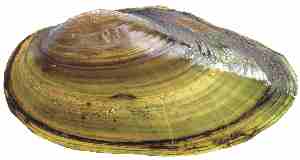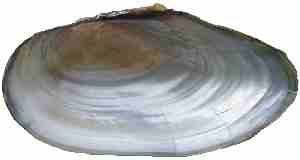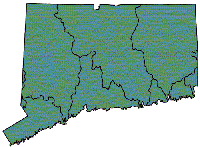Eastern Floater
Pyganodon cataracta
Key Features
Size: Up to seven inches, though infrequently specimens may grow nearly ten inches long!
Shape: Somewhat elongate, with a rounded ventral margin. The hinge ligament is either straight or curves slightly upward. Valves laterally inflated, thin, and fragile.
Periostracum: Color yellowish-green, green, or greenish-brown. Shell rays either absent or very faint.
Lateral Teeth: Absent.
Pseudocardinal Teeth: Absent.
Nacre: Color silvery-white or metallic blue, sometimes with a yellowish tinge toward the beak cavity.
Often Confused With ... Alewife floater, creeper.

External shell

Internal shell, right valve

Hinge teeth
 Habitat: The eastern floater exists in a wide variety of habitats and substrate types. It is particularly tolerant of deep silt and mud at the bottom of lakes and ponds. It has been introduced into many man-made ponds such as farm ponds, where it thrives in the nutrient-rich water.
Habitat: The eastern floater exists in a wide variety of habitats and substrate types. It is particularly tolerant of deep silt and mud at the bottom of lakes and ponds. It has been introduced into many man-made ponds such as farm ponds, where it thrives in the nutrient-rich water.
Range in Connecticut: Statewide.
Conservation: The eastern floater is widespread and abundant in Connecticut, and unlike many other species, it is tolerant of habitat modification and many forms of pollution. Predators, such as muskrats and otters, may prefer this species because its thin shell is relatively easy to break.
Freshwater Mussel Fact Sheets
Eastern Pearlshell
Dwarf Wedgemussel
Triangle Floater
Brook Floater
Creeper
Eastern Elliptio
Eastern Floater
Alewife Floater
Eastern Pondmussel
Tidewater Mucket
Yellow Lampmussel
Eastern Lampmussel
The Freshwater Mussels of Connecticut
Content last updated on January 29, 2014.

